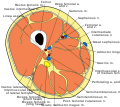Sartorius muscle
Sartorius muscle is a long, thin, superficial muscle that runs down the length of the thigh in the anterior compartment. It is the longest muscle in the human body. Its upper portion forms the lateral border of the femoral triangle.
Anatomy[edit]
The sartorius muscle originates from the anterior superior iliac spine on the lateral edge of the hip bone. From there, it runs obliquely across the upper and anterior part of the thigh in an inferomedial direction. It then descends to the medial side of the knee, passing behind the medial condyle of the femur to end in a tendon. This tendon curves anteriorly to join the tendons of the gracilis and semitendinosus muscles at the pes anserinus, where it inserts into the superomedial surface of the tibia.
Function[edit]
The sartorius muscle can perform all actions on the hip joint: flexion, abduction, and lateral rotation, and all actions on the knee joint: flexion and medial rotation. It is used when sitting cross-legged, and is sometimes referred to as the "tailor's muscle" because tailors historically sat in this position.
Clinical significance[edit]
Injury to the sartorius muscle or its nerve supply can cause a loss of the ability to perform its actions. This can result in difficulty with activities such as climbing stairs or bringing the knees to the chest.
See also[edit]
References[edit]
<references />
External links[edit]
| Muscles of the hip and human leg | ||||||||||||||||||
|---|---|---|---|---|---|---|---|---|---|---|---|---|---|---|---|---|---|---|
|
|
|
|
Sartorius muscle[edit]
-
Gray's Anatomy illustration of the sartorius muscle
-
Cross section of the thigh showing the sartorius muscle
-
Gray's Anatomy illustration of the muscles of the thigh
-
Gray's Anatomy illustration of the sartorius muscle in the leg
-
Anatomical dissection showing the sartorius muscle
-
Slide showing sartorius muscle anatomy
-
Slide showing sartorius muscle anatomy
-
Slide showing sartorius muscle anatomy
-
Slide showing sartorius muscle anatomy
-
Slide showing sartorius muscle anatomy
-
Slide showing sartorius muscle anatomy
-
Slide showing sartorius muscle anatomy
Ad. Transform your life with W8MD's Budget GLP-1 injections from $75


W8MD offers a medical weight loss program to lose weight in Philadelphia. Our physician-supervised medical weight loss provides:
- Weight loss injections in NYC (generic and brand names):
- Zepbound / Mounjaro, Wegovy / Ozempic, Saxenda
- Most insurances accepted or discounted self-pay rates. We will obtain insurance prior authorizations if needed.
- Generic GLP1 weight loss injections from $75 for the starting dose.
- Also offer prescription weight loss medications including Phentermine, Qsymia, Diethylpropion, Contrave etc.
NYC weight loss doctor appointmentsNYC weight loss doctor appointments
Start your NYC weight loss journey today at our NYC medical weight loss and Philadelphia medical weight loss clinics.
- Call 718-946-5500 to lose weight in NYC or for medical weight loss in Philadelphia 215-676-2334.
- Tags:NYC medical weight loss, Philadelphia lose weight Zepbound NYC, Budget GLP1 weight loss injections, Wegovy Philadelphia, Wegovy NYC, Philadelphia medical weight loss, Brookly weight loss and Wegovy NYC
|
WikiMD's Wellness Encyclopedia |
| Let Food Be Thy Medicine Medicine Thy Food - Hippocrates |
Medical Disclaimer: WikiMD is not a substitute for professional medical advice. The information on WikiMD is provided as an information resource only, may be incorrect, outdated or misleading, and is not to be used or relied on for any diagnostic or treatment purposes. Please consult your health care provider before making any healthcare decisions or for guidance about a specific medical condition. WikiMD expressly disclaims responsibility, and shall have no liability, for any damages, loss, injury, or liability whatsoever suffered as a result of your reliance on the information contained in this site. By visiting this site you agree to the foregoing terms and conditions, which may from time to time be changed or supplemented by WikiMD. If you do not agree to the foregoing terms and conditions, you should not enter or use this site. See full disclaimer.
Credits:Most images are courtesy of Wikimedia commons, and templates, categories Wikipedia, licensed under CC BY SA or similar.
Translate this page: - East Asian
中文,
日本,
한국어,
South Asian
हिन्दी,
தமிழ்,
తెలుగు,
Urdu,
ಕನ್ನಡ,
Southeast Asian
Indonesian,
Vietnamese,
Thai,
မြန်မာဘာသာ,
বাংলা
European
español,
Deutsch,
français,
Greek,
português do Brasil,
polski,
română,
русский,
Nederlands,
norsk,
svenska,
suomi,
Italian
Middle Eastern & African
عربى,
Turkish,
Persian,
Hebrew,
Afrikaans,
isiZulu,
Kiswahili,
Other
Bulgarian,
Hungarian,
Czech,
Swedish,
മലയാളം,
मराठी,
ਪੰਜਾਬੀ,
ગુજરાતી,
Portuguese,
Ukrainian














